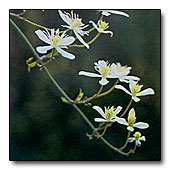Clematis terniflora
SWEET AUTUMN CLEMATIS
syn. C. dioscoreifolia, C. maximowicziana, C. paniculata
Family: Ranunculaceae
Pronounced: KLEM-uh-tiss

Quick Jumps
Growing Guide
Rainy Side Notes
GROWING GUIDE

Origin:
China, Korea, Japan and Taiwan.
Plant Group:
Vines.
Hardiness:
Sunset zones: All (Western).
USDA zones: 5-9.
Mature size:
Height: 6-10 feet (2-3 m).
Flowering period:
August to October.
Flowering attributes:
Fragrant, star-shaped, small white flowers.
Leaf attributes:
Deciduous, deep green leaves.
Light:
Tops in full sun or partial shade, feet in shade.
Soil:
Fertile, humus rich, well-drained soil.
Feeding:
Mulch well with composted manure or compost. Fertilize once a month with a complete organic fertilizer during the growing season.
Propagation Methods:
Layer branches in late winter.
Basal and softwood cuttings in spring.
Division in spring.
Semi-ripe cuttings in early summer.
Sow at 68°F (20°C), if no germination occurs in 4 weeks, move to 24-39°F (-4 to +4°C) for 4 weeks.
Pruning Methods:
Pruning group 3 or C.
Rainy Side Notes

Clematis terniflora sometimes cultivated under the name of C. dioscoreifolia, C. maximowicziana, and C. paniculata has enough name changes to keep your head spinning. My vine blooms from late August through September with sprinklings of blossoms continuing into October.
Sometime around 1818 this species was discovered. C. terniflora's common name, Sweet autumn clematis, aptly describes its time of flowering and its fragrance. I sit in my office in late summer with the window open, and the sweet smell wafts into the room. You can't find a better vine than this for fall bloom, and pleasant fragrance.
The clematis vigorously climbs all over a loose hedge of Viburnum trilobum instead of an inadequate trellis I provided for it. It is an excellent pairing especially with the numerous clusters of red Viburnum's berries surrounded by the abundant white flowers of the clematis vine.

Planting and Care of Clematis.
Photographed in author's garden.

Gardening for the Homebrewer: Grow and Process Plants for Making Beer, Wine, Gruit, Cider, Perry, and More
By co-authors Debbie Teashon (Rainy Side Gardeners) and Wendy Tweton
Copyright Notice | Home | Search | Vines

